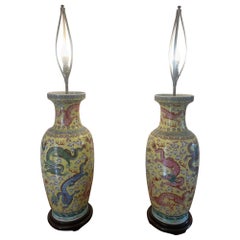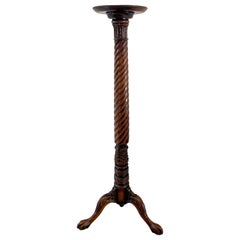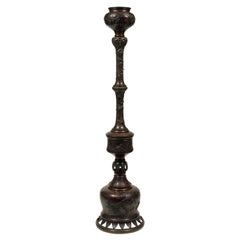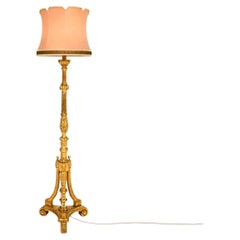London City Antiques Limited Floor Lamps
to
2
2
Height
to
Width
to
2
1
2
1
1
1
1
1
1
1
1
1
2
2
2
Large Pair of Antique 19th Century Chinese Porcelain Vase Lamps 105 x 24 cm
Located in Suffolk, GB
Large pair of antique 19th century Chinese porcelain vase lamps having magnificent hand painted dragons in wonderful red, blue and green colours and a wonderful yellow background col...
Category
Antique 19th Century Chinese Floor Lamps
Materials
Porcelain
Antique Victorian Quality Carved Mahogany Torchere
Located in Suffolk, GB
Antique Victorian quality carved mahogany torchere having a circular top with a moulded edge supported by a quality carved rope twist column standing on three shaped carved cabriole ...
Category
Antique 19th Century English Victorian Floor Lamps
Materials
Other
Related Items
19th Century Antique Japanese Meiji Bronze Floor Lamp
Located in Point Richmond, CA
19th century antique Japanese Meiji bronze floor lamp.
This finely cast, well composed, pedestal lamp depicts mythical creatures on the base, cranes in high relief on the stem are...
Category
Antique Late 19th Century Japanese Meiji Floor Lamps
Materials
Bronze
Antique Victorian Gilt Wood Floor Lamp
Located in London, GB
An absolutely stunning antique Victorian gilt wood floor lamp. This was made in England, it dates from around the 1890-1900 period.
It is of superb quality with fine and intricate d...
Category
Antique 1890s British Late Victorian Floor Lamps
Materials
Giltwood
Antique Torcheres Floor Candelabra
Located in Atlanta, GA
Pair of palatial iron torcheres with 17 lights.
Category
Antique 19th Century Italian Floor Lamps
Materials
Iron
Antique Victorian Brass Standard Lamp 19th Century
Located in London, GB
This is a highly attractive and exhibition quality antique late Victorian brass floor standard lamp now converted to electricity, circa 1890 in date.
This splendid lamp features a d...
Category
Antique 1890s English Victorian Floor Lamps
Materials
Brass
Antique Painted Iron Floor Torchere from France, Early 1900s
Located in Dallas, TX
This five light, antique French cast iron torchere has been painted deep green with gold colored bands around the motifs. The motifs are trefoils, ...
Category
Early 20th Century French Gothic Floor Lamps
Materials
Iron
Large 19th Century Pair of Bronze Figural Torcheres
By Ferdinand Barbedienne, A. Toussaint - G. Chaudoir
Located in London, GB
A pair of Figural Porte-Lumières, cast by Barbedienne from the celebrated Armand Toussaint Models
Constructed in bronze, and having a patinated natural, and a highlighted gilt patin...
Category
Antique Mid-19th Century French Romantic Floor Lamps
Materials
Bronze
Pair of Antique Victorian Floor Lamps
Located in London, GB
A fantastic pair of antique Victorian floor lamps. They were made in England, they date from around the 1880-1900 period.
They were probably originally large candle sticks...
Category
Antique 1880s British High Victorian Floor Lamps
Materials
Elm, Satinwood
Pair Antique Late 19th Century Chinese Porcelain Figural Lamps
Located in New Orleans, LA
Pair Antique Late 19th Century Chinese Porcelain Figural Lamps.
Symbolic Wise Man and Quan Yin / Mother Figure
Category
Antique Late 19th Century Chinese Table Lamps
Materials
Porcelain
Rare Finely Carved Pair of Teak Anglo-Indian Torcheres Jardinieres
Located in Montreal, QC
Rare finely carved pair of Teak Anglo-Indian torcheres jardinieres resting on trip pod base with carved birds at at each ends with floral carved motifs
Category
Antique 1850s Indian Floor Lamps
Materials
Teak
Pair of late 19th century copper Venetian lamps on poles
Located in Debenham, Suffolk
Pair of late 19th century copper venetian lamps on poles circa 1890.
Hexagonal in shape with original glass. Later converted to electric. Beautifully pressed and pierced metalwork,...
Category
Antique Late 19th Century Italian Renaissance Revival Floor Lamps
Materials
Copper
Pair of 19th Century Chinese Canton Baluster Porcelain Antique Table Lamps
Located in London, GB
A fine pair of Chinese late 19th century Canton medallion vases, decorated in the Famille rose palette. Now mounted as lamps with hand gilded turned bases.
Height of vases 16 1/2 ...
Category
Antique 19th Century Chinese Table Lamps
Materials
Porcelain
$9,389
H 16.54 in Dm 9.06 in
Pair of Monumental French Antique Marble and Bronze Candelabra Torcheres
Located in London, GB
This pair of fine candelabra torcheres take form on a monumental scale, each of them standing almost two and a half metres tall. The casting is superior in its quality and could be attributed to one of the 19th century masters, such as Deniere or Barbedienne. Each torchere is formed of a fluted veined marble column set...
Category
Antique Late 19th Century French Neoclassical Torchères
Materials
Marble, Ormolu, Bronze
$204,408 / set
H 95.67 in W 22.05 in D 17.72 in



